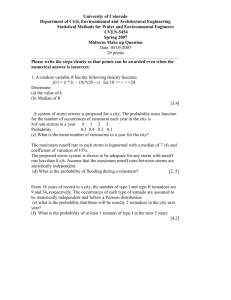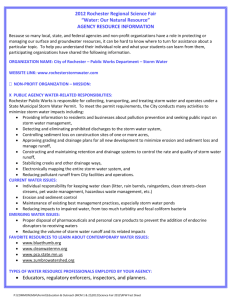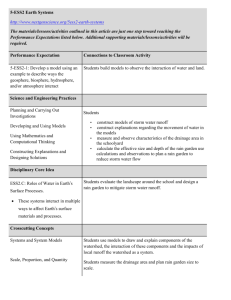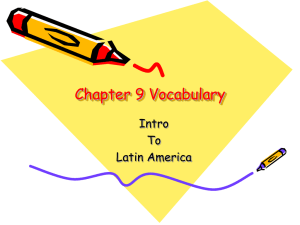INTRODUCTION CHAPTER 1
advertisement
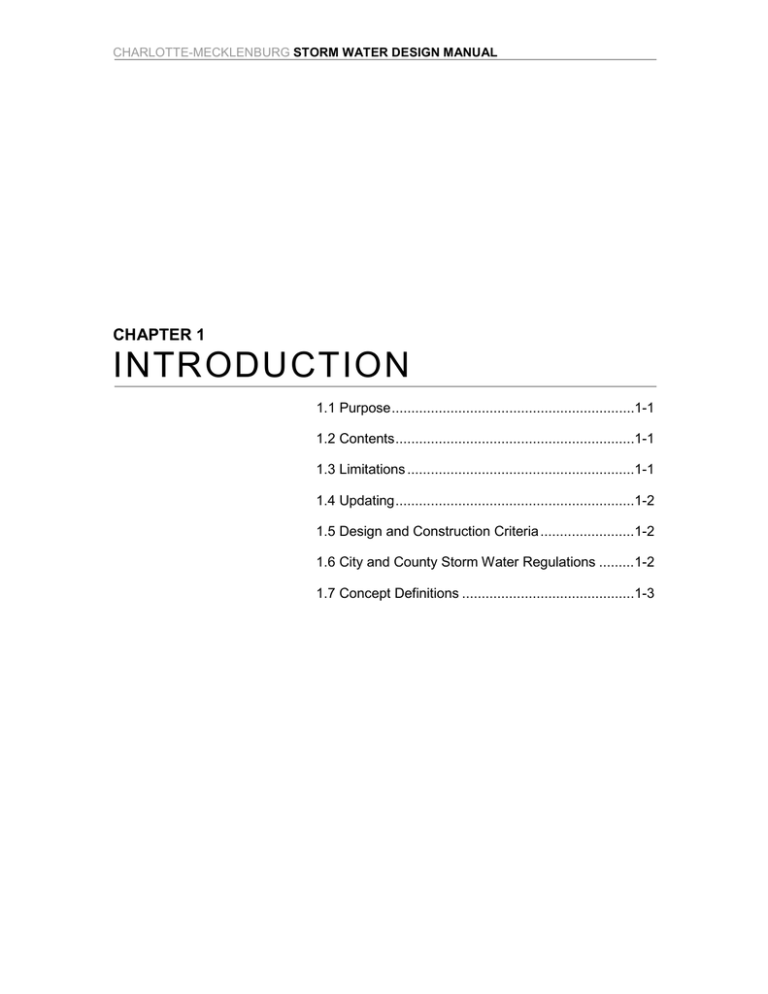
CHARLOTTE-MECKLENBURG STORM WATER DESIGN MANUAL CHAPTER 1 INTRODUCTION 1.1 Purpose ..............................................................1-1 1.2 Contents .............................................................1-1 1.3 Limitations ..........................................................1-1 1.4 Updating .............................................................1-2 1.5 Design and Construction Criteria ........................1-2 1.6 City and County Storm Water Regulations .........1-2 1.7 Concept Definitions ............................................1-3 1-0 CHAPTER 1 INTRODUCTION 1.1 PURPOSE This manual has been developed to assist in the design and evaluation of storm water management facilities in the City of Charlotte and Mecklenburg County. It provides engineering design guidance to: • local agencies responsible for implementing the Charlotte-Mecklenburg Storm Water Management Program • engineers responsible for the design of storm water management structures • developers involved in site planning and design • others involved in storm water management at various levels who may find the manual useful as a technical reference to define and illustrate engineering design techniques When accompanied by sound engineering judgment, application of the procedures and criteria presented in this manual should contribute toward the effective and economical solutions of local drainage and flooding problems. Engineering design methods other than those included in this manual may be used if approved by the City or County Engineering Department. Complete documentation of these methods may be required for approval. 1.2 CONTENTS The manual presents technical and engineering procedures and criteria needed to comply with Charlotte and Mecklenburg County storm water regulations. Following are the chapters included in the manual. • Chapter 1 Introduction • Chapter 2 Hydrology • Chapter 3 Open Channel Hydraulics • Chapter 4 Storm Drainage Systems • Chapter 5 Design of Culverts • Chapter 6 Storage and Detention • Chapter 7 Energy Dissipation Each chapter contains the equations, charts and nomographs needed to design specific storm water management facilities. Example problems are used to illustrate the use of the procedures. Where appropriate, desktop procedures are developed for design application. In addition, available computer programs are referenced and users are encouraged to obtain certain computer programs for design application. 1.3 LIMITATIONS The manual provides a compilation of readily available literature relevant to storm water management activities in the Charlotte-Mecklenburg area. Although it is intended to establish uniform design practices, it neither replaces the need for engineering judgment nor precludes the use of information not presented. Since material presented was obtained from numerous publications and has not been duplicated in its entirety, the user is encouraged to obtain original or additional reference material, as appropriate. References are included at the end of the manual. 1-1 CHARLOTTE-MECKLENBURG STORM WATER DESIGN MANUAL 1.4 UPDATING The Charlotte-Mecklenburg Storm Water Design Manual is a dynamic document available at www.charmeck.org/stormwater/regulations/Pages/StormWaterDesignManual.aspx and is updated periodically. It is the responsibility of the user to make sure the most recent standards are being specified. Users may request to receive notification of future revisions. The current manual is available via download only from this website. Hard copies or CDs of the Design Manual are no longer available from the City. 1.5 DESIGN AND CONSTRUCTION CRITERIA The following criteria will be used for the design and construction of all storm water facilities. • • • • • • • • • Discharge leaves site in the same direction and relative location as pre-developed condition. Design and installation of all storm water detention facilities must comply with applicable federal, state and local laws. Attention should be given to the applicable Soil Erosion and Sediment Control Ordinances, Post Construction Stormwater Ordinance, and the North Carolina Dam Safety Law. In no case shall a structure be located within the impoundment area of any storm water storage facility or over a storm drainage line. No utilities (sewer lines, power line, water line, etc.) shall be located within or under any detention facility. Detention facilities located within code-required automobile parking areas shall not exceed a maximum water depth of 6 inches. Additional criteria are listed in Chapter 6, section 6.2.5. With the exception of erosion control facilities, all detention facilities shall be considered permanent. Routine maintenance of all detention facilities shall be the responsibility of the property owner or appointed designee. It is recommended that storm water detention facilities be located on the site from which the runoff to be controlled is generated. Off-site detention facilities are acceptable provided the land area involved with the facility is delineated on an acceptable map and officially recorded at the Mecklenburg County’s Register of Deeds Office as a “Permanent Detention Easement”. Also, an official commitment to maintenance of the facility will be required. 1.6 CITY AND COUNTY STORM WATER REGULATIONS It is the responsibility of the user to be fully aware of all applicable federal, state, and local code requirements when using the Storm Water Design Manual such as, but not limited to: • Floodplain Regulations • Post Construction Stormwater Ordinance • Soil Erosion and Sediment Control • Stormwater Ordinance • Subdivision Ordinance 1-2 CHAPTER 1 INTRODUCTION • Zoning Ordinance 1.7 CONCEPT DEFINITIONS Unless specifically defined in this section, words or phrases used in this manual shall be interpreted so as to give them the meaning they have in common usage and to give this manual its most reasonable application. The following words, terms and phrases, when used in this manual, shall have the meanings ascribed to them in this section and shall be italicized, except where the context clearly indicates a different meaning. Antecedent Moisture Antecedent soil moisture conditions are the soil moisture conditions of the watershed at the beginning of a storm. These conditions affect the volume of runoff generated by a particular storm event. Notably they affect the peak discharge only in the lower range of flood magnitudes for example below about the 10-year event threshold. As the yearly storm event increases, antecedent moisture has a rapidly decreasing influence on runoff. Bypass Flow which bypasses an inlet on grade and is carried in the street or channel to the next inlet downgrade. Combination Inlet A drainage inlet composed of a curb-opening and a grate. This is a Charlotte-Mecklenburg standard catch basin on roadways. CMP The abbreviation for Corrugated Metal Pipe. Critical Depth Critical depth can best be illustrated as the depth at which water flows over a weir, this depth being attained automatically where no other backwater forces are involved. This is because it is the depth at which the energy content of flow is at a minimum. For a given discharge and crosssection geometry there is only one critical depth. Cross-drain Culverts and pipes that are used to convey runoff from one side of a roadway to another. Crown Crown refers to the highest part of the pipe (inside top). Culvert A structure that conveys any flow collected in an open ended pipe (i.e., headwall, flared end section, mitered end), a cross-drain. Curb-Opening Inlet A drainage inlet consisting of an opening in the roadway curb. Depression Storage Depression storage is the natural depressions within a watershed which store runoff. Generally, after the depression storage is filled runoff will commence. 1-3 CHARLOTTE-MECKLENBURG STORM WATER DESIGN MANUAL Drop Inlet A drainage inlet with a horizontal or nearly horizontal grate, generally located outside of the roadway. Equivalent Cross Slope An imaginary continuous cross slope having conveyance capacity equal to that of the given compound cross-slope. Flanking Inlets Inlets placed upstream and on either side of an inlet at the low point in a sag vertical curve. The purpose of these inlets is to intercept debris as the slope decreases and to act in relief of the inlet at the low point. Freeboard Freeboard is an additional depth (to the top of a basin, pond, ditch, etc.) regarded as a safety factor, above the peak design water elevation. Free Outlets Free outlets are those outlets whose tailwater is equal to or lower than critical depth. For culverts having free outlets, lowering of the tailwater has no effect on the discharge or the backwater profile upstream of the tailwater. Frequency Frequency is the average time interval between equal magnitude storm events. For example, a 25-year storm event has the probability of occurrence of once every 25 years on the average, or a 4 percent chance of occurrence in any given year. Frontal Flow The portion of the gutter flow which passes over the upstream side of a grate. Grate Perimeter The sum of the lengths of all sides of a grate. For grated inlets on curbs, neglect the side adjacent to the curb and use only three sides. Gutter That portion of the roadway section adjacent to the curb which is utilized to convey storm water runoff. HDPE The abbreviation for High Density Polyethylene. Hydraulic Grade Line (HGL) The hydraulic grade line is the set of elevations to which the water would rise in successive piezometer tubes if the tubes were installed along a pipe system. Hydraulic Roughness Hydraulic roughness is a composite of the physical characteristics which influence the flow of water across the earth’s surface, whether natural or channelized. It affects both the time response of a watershed and drainage channel as well as the channel storage characteristics. Hydrograph The hydrograph is a graph of the time distribution of runoff from a watershed. 1-4 CHAPTER 1 INTRODUCTION Hyetograph The hyetograph is a graph of the time distribution of rainfall over a watershed. Improved Inlets Flared, improved, or tapered inlets indicates a special entrance condition which decreases the amount of energy needed to pass the flow through the inlet and thus increases the capacity of culverts at the inlet. Infiltration Infiltration is a complex process of allowing runoff to penetrate the ground surface and flow through the upper soil surface. The infiltration curve is a graph of the time distribution at which this occurs. Initial Abstractions All losses (water retained in surface depressions, water intercepted by vegetation, evaporation, and infiltration) before surface water runoff begins. Inlet Efficiency The ratio of flow intercepted by an inlet to total flow in the gutter. Interception Storage of rainfall on foliage and other intercepting surfaces during a rainfall event is called interception storage. Invert Invert refers to the flowline (lowest part) of the pipe (inside bottom) or channel. Lag Time The lag time is defined as the time from the centroid of the excess rainfall to the peak of the runoff hydrograph. Peak Discharge The peak discharge, sometimes called peak flow, is the maximum rate of flow of water passing a given point during or after a rainfall event. Pressure Head Pressure head is the height of a column of water that would exert a unit pressure equal to the pressure of the water. Primary Access Streets A street serving as the only access to parcel(s). Rainfall Excess Rainfall excess is the excess water available to runoff after interception, depression storage, and infiltration have been satisfied. RCP The abbreviation for Reinforced Concrete Pipe. Scupper A vertical hole through a bridge deck for the purpose of deck drainage. Sometimes, a horizontal opening in the curb or barrier is called a scupper. 1-5 CHARLOTTE-MECKLENBURG STORM WATER DESIGN MANUAL Side-Flow Interception Flow which is intercepted along the side of a grate inlet, as opposed to frontal interception. Splash Over Portion of the frontal flow at a grate which skips or splashes over the grate and is not intercepted. Spread The width of flow measured perpendicularly from the roadway pavement edge or the lip of the gutter. Steep and Mild Slope A steep slope culvert operation is where the computed critical depth is greater than the computed uniform depth. A mild slope culvert operation is where critical depth is less than uniform depth. Submerged Inlets Submerged inlets are those inlets having a headwater greater than 1.5 times the pipe diameter (1.5D). Submerged Outlets Partially submerged outlets are those outlets whose tailwater is higher than critical depth and lower than the height of the culvert. Submerged outlets are those outlets having a tailwater elevation higher than the crown of the culvert. Lowering of the tailwater may have significant effect on the discharge or the backwater profile upstream of the tailwater. Stage The stage of a channel or detention facility is the elevation of the water surface above some elevation datum. Storm Drain A pipe used for the conveyance of storm water. Thoroughfare A street designated as a major or minor thoroughfare as shown on the Charlotte-Mecklenburg Thoroughfare Plan. Time of Concentration The time of concentration is the time required for water to flow from the most hydraulically remote point of the basin to the location being analyzed. Thus the time of concentration is the maximum time for water to travel through the watershed, which is not always the maximum distance from the outlet to any point in the watershed. Uniform Flow Uniform flow is flow in a prismatic channel of constant cross section having a constant discharge, velocity and depth of flow throughout the reach. Unit Hydrograph A unit hydrograph is the direct runoff hydrograph resulting from a rainfall event which has a specific temporal and spatial distribution and which lasts for a specific duration of time (thus there could be a 5-, 10-, 15-minute, etc., unit hydrograph for the same drainage area). The ordinates of the unit hydrograph are such that the volume of direct runoff represented by the area under the hydrograph is equal to one inch of runoff from the drainage area. 1-6 CHAPTER 1 INTRODUCTION Usable and Functional Part of the Structure “Usable and functional part of the structure” shall be defined as being inclusive of living areas, basements, sunken dens, basement utility rooms, crawlspaces, attached carports, and mechanical appurtenances such as furnaces, air conditioners, water pumps, electrical conduits and wiring, but shall not include water lines or sanitary sewer traps, piping and clean-outs. Velocity Head A quantity proportional to the kinetic energy of flowing water expressed as a height or head of water. 1-7

